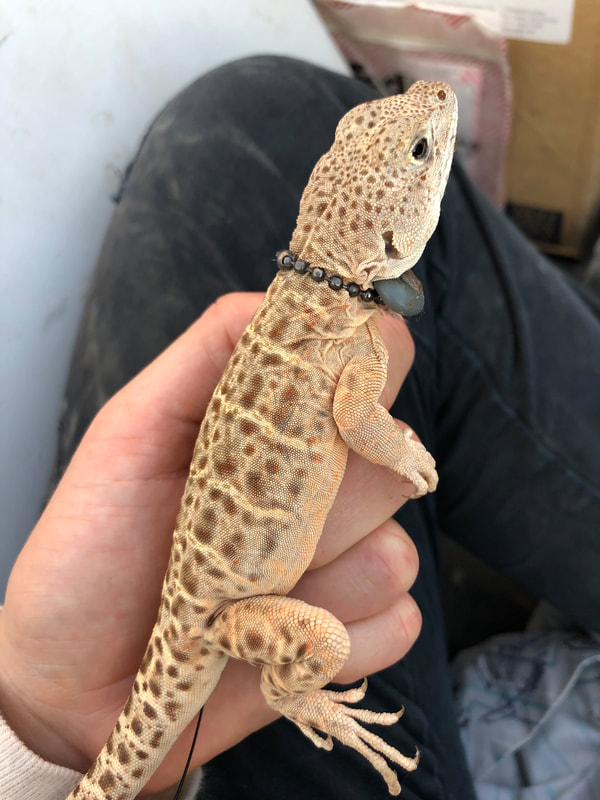2020 WINNER: SAVANNAH WEAVER
PROJECT: Blunt-nosed Leopard Lizard Hydrophysiology The First Step in Multi-Species Conservation

Project Introduction:
Savannah's project will look into understanding Blunt-nosed leopard lizard (Gambelia sila) hydration and hydroregulation, hereafter collectively referred to as hydrophysiology, is an essential and currently missing conservation piece for both Gambelia sila and the greater San Joaquin Desert. In California’s San Joaquin Desert, many endemic species are endangered and at risk of extinction as agriculture, oil development, and urbanization continue to deplete their habitat. Blunt-nosed leopard lizards only occupy 15% of their original range due to human development and provide a unique conservation opportunity. As a charismatic species known for their bright colors and bipedal sprints, there is potential for widespread public conservation support.
Among many endangered species of the San Joaquin Desert, the extant Gambelia sila range encompasses the most geographic area of other species’ ranges. Therefore, following the “umbrella species” concept, conservation of this species would a whole assemblage of sensitive, threatened, and endangered species.
Savannah's project will look into understanding Blunt-nosed leopard lizard (Gambelia sila) hydration and hydroregulation, hereafter collectively referred to as hydrophysiology, is an essential and currently missing conservation piece for both Gambelia sila and the greater San Joaquin Desert. In California’s San Joaquin Desert, many endemic species are endangered and at risk of extinction as agriculture, oil development, and urbanization continue to deplete their habitat. Blunt-nosed leopard lizards only occupy 15% of their original range due to human development and provide a unique conservation opportunity. As a charismatic species known for their bright colors and bipedal sprints, there is potential for widespread public conservation support.
Among many endangered species of the San Joaquin Desert, the extant Gambelia sila range encompasses the most geographic area of other species’ ranges. Therefore, following the “umbrella species” concept, conservation of this species would a whole assemblage of sensitive, threatened, and endangered species.
HCI Q&A With Savannah weaverThis year one of our fantastic Michael Dee Grant recipients is Savannah Weaver of Cal-Poly San Luis Obispo. Savannah has worked on numerous research projects. Her current project looks at multi-species conservation through the understanding of how desert species cope with a changing climate and harsh environment. Using the Blunt-nosed Leopard Lizard (Gambelia sila) as a representative/umbrella species. But just who is Savannah Weaver and why does she care so much about thirsty lizards? Let’s find out.
Where are you from? “I am originally San Jose, grew up there, went to PA for undergrad, then travelled to Western Colorado, Ghana and Australia.” What set you on this path to becoming a lizard-loving conservationist? I didn’t realize how cool nature was until I left California for college and was surrounded by other academics, and like-minded people. That’s when I figured out that nature and science is where it’s at!” |

I took an amphibian conservation class in my undergrad, in central Pennsylvania. I was immediately obsessed. It was magnificent. Everyone thinks that mammals and birds are the coolest but Herps are the underdogs and there are so many people championing them, I just wanted to join. The people studying herpetology are awesome. I also found my mentor Emily Taylor, I realized I have to work with this person.”
Why The blunt-nosed leopard lizard? What made you say “That’s the animal I want to work with”.
My personal connection wasn’t established until very recently. As soon as I started working with them I became obsessed, they certainly have personalities. What’s really amazing is that they are only active from about April to July or August. So they are out when it’s nice for us to be out. You have to get up super early to see birds or stay up all night to see amphibians. They also spend so much time hiding, that when they come out it's something special.
People are going to want to know, how does a lizard’s hydration lead to multi-species conservation?
If you think about humans when we are hot, we get thirsty, we sweat and breathe and lose a lot of water that way. Desert animals have some adaptations for dealing with the desert heat but they aren't perfect. Heat causes stress so they have to find ways to reduce the amount of water they need. Understanding how species cope with the desert environment currently will also help us understand how they will deal with a changing climate. We are studying this in this one species because the Blunt-nosed Leopard lizard is physically large enough to carry a collar and have blood taken frequently with no/minimal negative effects. This work will also be done under federal permitting.
There are a ton of diversity and species that live in the desert with little to no water. Deserts are the most stressful environments to live in, and the way animals cope is through really cool adaptation. There’s a ton of diversity and different organisms have different ways of coping. Understanding the diversity of ways animals cope is really important because the more species we study the better we will be able to find trends and the most “popular” strategies for desert adaptations. If we can see how they adapt then we can compare them to other desert reptile species.”
Who are some of your influences?
“Oh man, my mentors, the professors and the research advisors I've had who encouraged my research. They've been the ones that pushed me to be a good student and a good researcher and given me so many opportunities, and in doing that they have become my role models. They were always there telling me that I could actually do this. I just really look up to my mentors Dr. Emily Taylor (Cal Poly) and Dr. Jodi Rowley (Australian Museum) who are both amazing herpetologists and women in science. I think that’s really important.”
What are some of the challenges you are anticipating?
“Luckily, we aren't actively working when it's the harshest weather, like midday, since the lizards aren't out either.
The biggest challenge is that there are so many things that I want to measure but so little time. Doing blood sampling and physiological things in the field is always hard. Also losing individuals or not being able to find and track them. I am still making choices on what I can do versus what I would ideally do.
What’s the future looking like for you?
“I see a life studying herps. They are just amazing model organisms for coping with a changing climate. Right now I’m just a measly masters student, but in like 2 and half years I’ll be finishing my Masters and heading into my PhD. Herpetology and science aren't getting rid of me!”
Is there anything else I should know?
I just want to reiterate how grateful I am, it's an honor to receive something with Michael Dee’s name on it.
Resulting Publication:
Savannah J Weaver, Ian J Axsom, Lindsay Peria, Tess McIntyre, Justin Chung, Rory S Telemeco, Michael F Westphal, Emily N Taylor, Hydric physiology and ecology of a federally endangered desert lizard, Conservation Physiology, Volume 12, Issue 1, 2024, coae019, https://doi.org/10.1093/conphys/coae019
Why The blunt-nosed leopard lizard? What made you say “That’s the animal I want to work with”.
My personal connection wasn’t established until very recently. As soon as I started working with them I became obsessed, they certainly have personalities. What’s really amazing is that they are only active from about April to July or August. So they are out when it’s nice for us to be out. You have to get up super early to see birds or stay up all night to see amphibians. They also spend so much time hiding, that when they come out it's something special.
People are going to want to know, how does a lizard’s hydration lead to multi-species conservation?
If you think about humans when we are hot, we get thirsty, we sweat and breathe and lose a lot of water that way. Desert animals have some adaptations for dealing with the desert heat but they aren't perfect. Heat causes stress so they have to find ways to reduce the amount of water they need. Understanding how species cope with the desert environment currently will also help us understand how they will deal with a changing climate. We are studying this in this one species because the Blunt-nosed Leopard lizard is physically large enough to carry a collar and have blood taken frequently with no/minimal negative effects. This work will also be done under federal permitting.
There are a ton of diversity and species that live in the desert with little to no water. Deserts are the most stressful environments to live in, and the way animals cope is through really cool adaptation. There’s a ton of diversity and different organisms have different ways of coping. Understanding the diversity of ways animals cope is really important because the more species we study the better we will be able to find trends and the most “popular” strategies for desert adaptations. If we can see how they adapt then we can compare them to other desert reptile species.”
Who are some of your influences?
“Oh man, my mentors, the professors and the research advisors I've had who encouraged my research. They've been the ones that pushed me to be a good student and a good researcher and given me so many opportunities, and in doing that they have become my role models. They were always there telling me that I could actually do this. I just really look up to my mentors Dr. Emily Taylor (Cal Poly) and Dr. Jodi Rowley (Australian Museum) who are both amazing herpetologists and women in science. I think that’s really important.”
What are some of the challenges you are anticipating?
“Luckily, we aren't actively working when it's the harshest weather, like midday, since the lizards aren't out either.
The biggest challenge is that there are so many things that I want to measure but so little time. Doing blood sampling and physiological things in the field is always hard. Also losing individuals or not being able to find and track them. I am still making choices on what I can do versus what I would ideally do.
What’s the future looking like for you?
“I see a life studying herps. They are just amazing model organisms for coping with a changing climate. Right now I’m just a measly masters student, but in like 2 and half years I’ll be finishing my Masters and heading into my PhD. Herpetology and science aren't getting rid of me!”
Is there anything else I should know?
I just want to reiterate how grateful I am, it's an honor to receive something with Michael Dee’s name on it.
Resulting Publication:
Savannah J Weaver, Ian J Axsom, Lindsay Peria, Tess McIntyre, Justin Chung, Rory S Telemeco, Michael F Westphal, Emily N Taylor, Hydric physiology and ecology of a federally endangered desert lizard, Conservation Physiology, Volume 12, Issue 1, 2024, coae019, https://doi.org/10.1093/conphys/coae019



